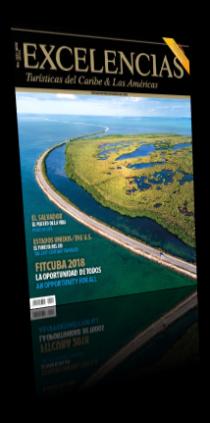- Rewarding Nature
VILLA CLARA: A NEW DREAM FOR TRAVELERS EAGER TO DISCOVER UNEXPLORED PLACES
I bet an unforgettable experience like the one that floods the senses and leaves in us the desire to repeat the experience, will be engraved in those attending the International Tourism Fair (FITCuba 2018), when they leave Santa Maria Key, in Villa Clara, the venue of this year’s event.
They would no doubt think that only a single act of magic could muster so much history, culture and traditions in a region where lakes, plains, mountains, colonial villas and a sun-and-beach destination turn this place into a prize of nature.
Located in the center of the Cuban archipelago, Villa Clara abuts the Gulf of Mexico to the north, as well as the Straits of Florida and the Bahamas Old Channel. To the south, the provinces of Sancti Spíritus and Cienfuegos border it. Its capital is the city of Santa Clara, founded in 1689. Here lie the remains of Ernesto Che Guevara. Thousands of people from around the world visit the two memorials each year, a respectful pilgrimage to the sites that remember his historical bond with the city: the Monument to the Taking of the Armored Train and the Sculptural Complex where the remains of the larger-than-life Argentine-Cuban guerrilla leader and his fallen colleagues in Bolivia rest.
As a province, Villa Clara boasts other unique attractions. The city of Remedios, the eighth Villa founded over 500 years ago by the Spaniards; the spa of mineral-medicinal and thermal waters of Elguea, famous for its healing power; and Hanabanilla, the country’s largest intermountain dam.
The selection of Villa Clara as the venue of FITCuba 2018 is the icing on the cake for the launch of this place as a new travel circuit, a destination that integrates a mesh of cities and towns with high historical values –heritages like Santa Clara, Remedios and Sagua la Grande, along with a fantastic sun-and-beach destinations that goes from the city of Caibarien all the way to the keys of Santa Maria, Ensenachos and Las Brujas, where a first-class hotel infrastructure has been built in terms of comfort and conveniences, harmoniously melted into the surrounding nature.
Just driving from Caibarien to Santa Maria Key, down a causeway or rock-paved road that runs over the sea along 48 km, is good enough to hold your breath and let out a long sigh of satisfaction as you revel in that unique feeling of traveling on wheels, between the blue sky and deep blue sea, right under a bright sun, bathed by the refreshing sea breeze. It is enough to remember that this feat of Cuban civil engineering received the “Puente de Alcantara” International Prize in 1998-2000 as the Best Iberian-American Work.
EQUALLY VALUABLE HERITAGE
Numerous works have been executed or are in the works to beef up the emerging tourist circuit of Villa Clara as the fourth most important of its kind on the island nation, just trailing behind Havana, Varadero and Holguin. According to press reports, Regla Dayamí Armenteros Mesa, delegate of the Ministry of Tourism in Villa Clara, there’s a number of hotels that are undergoing restoration, plus several new builds, like the one down the Santa Clara-Santa Maria Key route. There are two of them –Florida and Floreale- in provincial capital; Cosmopolitan in Camajuaní; Bauzá and Leyenda in Remedios; Comercio in Caibarién; and in Sagua la Grande, El Sagua, all run under Cubanacán’s Encanto luxury chain and featuring four-star category.
These facilities, with the addition of Hotel Central near the Vidal Park, plus other guestrooms and recreational areas in the La Granjita, the Americas and Los Caneyes hotels, all in Santa Clara, expand the territory’s accommodation capacity by adding more rooms to cultural and patrimonial tourism modes, of increasing demand in foreign markets.
In Remedios, the extra-hotel service is complemented by the restoration of the Louvre Cafeteria, the oldest in operation in Cuba; the Siete Juanes Tavern, the Doña Lala Ice Cream Parlor, the El Golazo Sport Bar and the El Curujey restaurant.
BEAUTIFUL KEYS
Internationally recognized for the beauty of its natural environment and the existence of numerous high-standard hotels, Santa Maria Key is an islet of 21,4 square kilometers located in the central part of the Jardines del Rey archipelago (Sabana-Camagüey). Along with its peers –Ensenachos, Las Brujas, Francés and Cobos, among many others (there are around 500 of them)- they make up the insular subsystem called Cayos de la Herradura.
The keys off the central region’s north coast are labeled as one of the best-preserved areas of the country, with the second formation of mangroves in Cuba, let alone a high percentage of floral and wildlife endemism.
The investment plan for the ongoing year includes the development of Cayo Esquivel, north of Sagua la Grande, a site of enormous potential for tourism, the possibility to run a five-star luxury hotel is in the offing. Last year, after a grand tour around this place, Cuba’s Tourism Minister Manuel Marrero said that all possible offers and identified potential foreign investors must be ready by the opening of FITCuba 2018, as well as the demands and needs for what he calls “a destination of unparalleled beauty.”































































































































